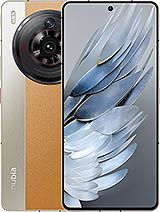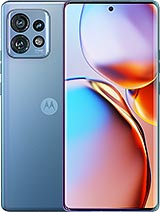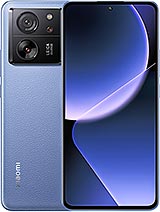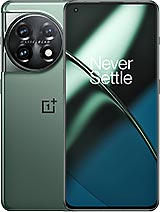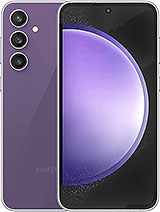nubia Z50S Pro review

High-res 6.78-inch OLED on the front
The nubia Z50S Pro features a 6.78-inch OLED display with a somewhat unusual resolution of 1,260x2,800px (20:9 aspect ratio). The higher number of pixels across a more or less standard size means a higher-than-most pixel density of 452ppi. The panel supports up to 120Hz refresh rate, has 2160Hz PWM (pulse-width modulation) dimming, and can display up to a billion colors.

When testing its brightness, we measured 1029nits with adaptive brightness enabled and the phone placed under bright light. That's slightly short of the Xiaomi 13T Pro and the Motorola Edge 40 Pro's results under the same conditions, but comfortably ahead of the OnePlus 11. The nubia is among the brightest in its class when you adjust the slider manually, managing over 600nits, with 500-ish being par for the course.
Color accuracy
Color handling on the nubia Z50S Pro is done in fairly straightforward way. There are three main color modes, plus a three-position warm-default-cool slider and a color wheel for further tweaking.
Standard mode is very well-tuned for DCI-P3 content and returns an average dE2000 of 1.7 for our set of test swatches. Soft mode delivers an even better accuracy for sRGB content, while Colorful mode opts for an outright vivid presentation and even wider gamut than Standard.
Refresh rate
The Z50S's refresh rate menu offers four options - Auto, 120Hz, 90Hz, and 60Hz, but its behavior is rather limited in its adaptability. The auto and 120Hz modes will maintain 120Hz for a few moments and then switch down to 90Hz when idle. Fullscreen video playback will default to 60Hz, though when browsing the UI of the video app, you'll be getting the 120-90Hz switch.

The 90Hz mode sets the cap at that value but will also switch down to 60Hz for fullscreen video, while 60Hz is 60Hz throughout. All the games we tried were also capped at 60Hz in all modes, sadly.
Streaming and HDR
There's no mention of HDR capabilities in the nubia's specs, but we found it to be getting HDR streams from YouTube - with the brightness boost and expressive colors that go with it. There was no HDR support in Netflix, but we did at least get FullHD streams thanks to the Widevine L1 certification.
nubia Z50S Pro battery life
The Z50S Pro is powered by a 5,100mAh battery - that's 100mAh more than what most phones have, and a higher capacity than potential competitors.
In our Active Use test, the phone posted consistently high marks across all tests, with standout numbers in video playback and gaming - certainly a worthy companion for extended play dates.
Charging speed
The bundled adapter in the nubia Z50S Pro's box is rated for up to 80W of charging. In our experience, it took a little over half an hour to get the phone from empty to 100%, and we were looking at 55% in the battery indicator at the 15-minute mark.

The 34-minute full charge result is admittedly a little bit slower than the likes of the Xiaomi 13T Pro or the OnePlus 11, but is a pretty solid showing and notably better than the speeds you'd get from a Galaxy S23 FE or a Zenfone 10. Likewise, the rapid charging at the early stages may not be class-leadingly rapid, but it is quite speedy nonetheless.
The Nubia is missing wireless charging, and so too are the Xiaomi and the OnePlus. Most of the other models mentioned above do support wireless charging at one speed or another, so if you're into induction, there are alternatives for Z50S Pro money or less.
Speaker test
The Z50S Pro features a stereo speaker setup with one speaker firing out the bottom of the handset and another one that outputs towards the top but also forward to serve as an earpiece.
Regardless of orientation, the top unit is assigned the left channel, and the right one goes to the bottom driver - if you want the correct channels coming out of the correct speakers in the landscape, you better have the phone with the buttons facing up.
In our speaker test, the nubia earned a 'Very Good' score for loudness - a notch above the Xiaomi 13T Pro, on par with the OnePlus 11, but one level below the Motorola Edge 40 Pro.
In terms of sound quality, the Z50S Pro delivers clear vocals and sparly treble but little in the way of bass. The Xiaomi sounds similar; the OnePlus is better in the low-end, and so is the Moto, but that one isn't as good in the higher frequencies.
Use the Playback controls to listen to the phone sample recordings (best use headphones). We measure the average loudness of the speakers in LUFS. A lower absolute value means a louder sound. A look at the frequency response chart will tell you how far off the ideal "0db" flat line is the reproduction of the bass, treble, and mid frequencies. You can add more phones to compare how they differ. The scores and ratings are not comparable with our older loudspeaker test. Learn more about how we test here.
Reader comments
- Menai
- 12 Mar 2025
- Jep
They need to stop selling their phones in eu because they don't get any software updates and patches security for their price between 550€ and 780€ don't buy this brand of phones
- SCEA
- 02 Nov 2024
- 8Vx
Today November 1st I just got the latest update to MyOS 13.5.10 NX713J GB. Just some stability fixes and battery improvements. Nothing else. Seems like your usual "stability" update.
- TheWorld
- 10 Oct 2024
- vaY
ZTE and all their sub-brands a terrible ghost 👻 company. They sell well over $800 USD devices around the globe and they don't provide any OS and security updates. I recommend people to not buy any ZTE device, they don't deserve your money a...
